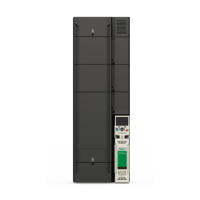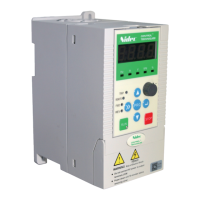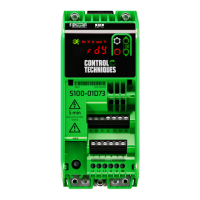Safety
information
Introduction
Product
Information
System
design
Mechanical
Installation
Electrical
Installation
Getting
started
Optimization Parameters
Technical
data
Component
sizing
Diagnostics
UL
Information
10 Unidrive M Regen Design Guide
Issue Number: 4
2 Introduction
The following Design Guide should be read in conjunction with the
relevant Unidrive M Control User Guide and Power Installation Guide.
Any Unidrive M600/M700/M701 drive can be configured as an AC
Regenerative Unit (hereafter referred to as a Regen drive).
It is possible to operate a Unidrive M702 in Regen Mode although it is
not recommended due to the lack of control connections required to fully
support Regen operation.
This Design Guide gives instructions for the drive connected to the
supply. For instructions regarding the drive connected to the motor,
please refer to the relevant Unidrive M Control User Guide and Power
Installation Guide.
This guide covers the following:
• Principles and advantages of operation in Regen mode
• Safety information
• EMC information
• Detailed information on additional components required
• System design
• Special considerations
• Installation
• Commissioning and optimization of the completed system
At least two Unidrive M drives are required to form a complete
regenerative system - one connected to the supply and the second one
connected to the motor. A Unidrive M in Regen mode converts the AC
mains supply to a controlled DC voltage, which is then fed into another
drive(s) to control a motor(s).
The motoring drive(s) in a Regen configuration could be another drive
other than a Unidrive M, e.g. Unidrive SP or Commander SK etc.
The following Regen components are also required in addition to the
Unidrive M drives.
1. Regen inductor
2. Switching frequency filter inductor
3. Switching frequency filter capacitor
4. Softstart resistor
5. Varistors
6. MCBs
7. Overload relays
2.1 Regen operation
For use as a regenerative front end for four quadrant operation.
Regen operation allows bi-directional power flow to and from the AC
supply. This provides far greater efficiency levels in applications which
would otherwise dissipate large amounts of energy in the form of heat in
a braking resistor.
The low frequency harmonic content of the input current is negligible due
to the sinusoidal nature of the waveform when compared to a
conventional bridge rectifier or thyristor front end.
2.2 Advantages of Unidrive M operating in
Regen mode
The main advantages of an AC Regen system are:
• Energy saving.
• The input current waveform is sinusoidal.
• The input current has a near unity power factor.
• Harmonic reduction feature.
• The output voltage for the motor can be higher than the available AC
mains supply.
• Possible to control reactive current or power (kVAr units).
• The Regen drive will synchronize to any frequency between 10 and
200 Hz, provided the supply voltage is within the supply
requirements (operating frequency range of 45 Hz to 66 Hz) refer to
section 6.2 Supply requirements on page 117.
• It is possible to configure the drive to continue operating for short
periods of time during supply dips and faults i.e. ride through.
• Island detection feature to prevent unwanted islanded operation,
where part of the power distribution network becomes separated
from the power grid and is unintentionally maintained by an inverter.
• The Regen and motoring drives are identical (when using
Unidrive M).
• Power feed-forward term available, using analog I/O set-up or fast
synchronous communications.
• A fast transient response is possible using the power feed forward
term.
• Voltage and frequency limits configurable.
2.3 Principles of operation
The input stage of a non-regenerative AC drive is usually an
uncontrolled diode rectifier, therefore power cannot be fed back onto the
AC mains supply. By replacing the diode input rectifier with a voltage
source PWM input converter (Unidrive M), AC supply power flow can be
bi-directional with full control over the input current waveform and power
factor. Currents can now be controlled to give near unity power factor
and a low level of line frequency harmonics.
In the case of a Unidrive M operating in regenerative mode, the IGBT
stage is used as a sinusoidal rectifier converting the AC supply to a
controlled DC voltage.
Furthermore, by maintaining the DC bus voltage above the peak supply
voltage the load motor can be operated at a higher speed without field
weakening. Alternatively, the higher output voltage available can be
exploited by using a motor with a rated voltage higher than the AC mains
supply, thus reducing the current for a given power.
The difference between the PWM line voltage and the supply voltage
occurs across the Regen inductors at the Regen drive. This voltage has
a high frequency component, which is blocked by the Regen inductor,
and a sinusoidal component at line frequency. As a result currents
flowing in these inductors are sinusoidal with a small high frequency
ripple component.
Regen inductors must be used to ensure a minimum source impedance,
these being selected and specified later in the guide.
Safe Torque Off function
The drive enable input is designed to offer the Safe Torque
Off safety function only when the drive is connected directly
to the motor. The enable input for the drive which is
connected to the AC supply works only as a simple enable
input for regenerative operation. It does not prevent power
from reaching the motor and it does not offer the Safe Torque
Off safety function. No attempt must be made to use it for a
safety function. Failure to observe this warning could result a
dangerous failure of a machinery safety function.
Any reference in this Design Guide to Safe Torque Off should
be taken to refer only to the enable function and not to any
safety function.

